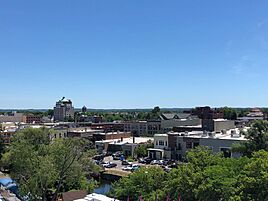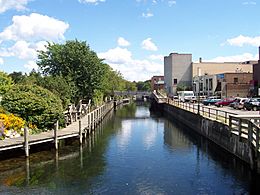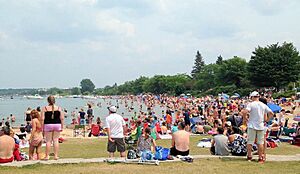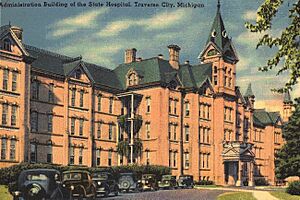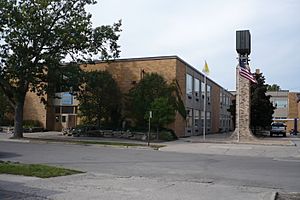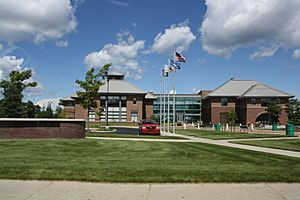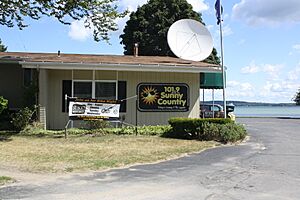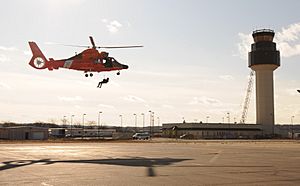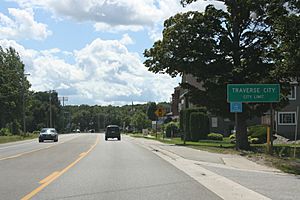Traverse City, Michigan facts for kids
Quick facts for kids
Traverse City, Michigan
|
|||||
|---|---|---|---|---|---|
|
Downtown Traverse City
Grand Traverse County Courthouse
State Theatre
|
|||||
|
|||||
| Etymology: French: la grande traverse (the long crossing) | |||||
| Nickname(s):
"Traverse", "T.C.", "The Cherry Capital (of the World)", "Cherryland", "Queen City of the North", "Coast Guard City", "Hockeytown North"
|
|||||
| Country | |||||
| State | |||||
| Counties | |||||
| Settled | June 13, 1847 | ||||
| Incorporated | April 18, 1881 (village) May 18, 1895 (city) |
||||
| Founded by | Perry Hannah, Albert Lay, Horace Boardman | ||||
| Government | |||||
| • Type | Council–manager | ||||
| Area | |||||
| • City | 8.61 sq mi (22.30 km2) | ||||
| • Land | 8.28 sq mi (21.43 km2) | ||||
| • Water | 0.34 sq mi (0.87 km2) | ||||
| Elevation | 626 ft (191 m) | ||||
| Population
(2020)
|
|||||
| • City | 15,678 | ||||
| • Estimate
(2023)
|
15,707 | ||||
| • Density | 1,894.39/sq mi (731.43/km2) | ||||
| • Metro | 153,448 (Traverse City metropolitan area) | ||||
| Demonym(s) | "Traverse Citian(s)" | ||||
| Time zone | UTC-5 (EST) | ||||
| • Summer (DST) | UTC-4 (EDT) | ||||
| ZIP code(s) |
49684, 49685, 49686, 49696
|
||||
| Area code(s) | 231 | ||||
| FIPS code | 26-80340 | ||||
| GNIS feature ID | 1615042 | ||||
Traverse City is a cool city in Michigan, USA. It's the main town for Grand Traverse County, but a small part of it is also in Leelanau County. In 2020, about 15,678 people lived here. The wider area around Traverse City has over 153,000 residents. It's the biggest city in Northern Michigan.
Traverse City sits at the end of the East and West parts of Grand Traverse Bay. This bay is about 32 miles (51 km) long and connects to Lake Michigan. The bay is split by the 18-mile (29 km) long Old Mission Peninsula, which starts right in Traverse City. The city is also next to four townships: East Bay, Elmwood, Garfield, and Peninsula.
Traverse City is often called "the Cherry Capital of the World." This is because the area around Grand Traverse Bay grows a lot of cherries. Every year, the city hosts the National Cherry Festival, which brings in about 500,000 visitors! The area is also famous for making wine. You can find two special wine-growing regions right next to the city. Traverse City is also home to the Traverse City State Hospital, which used to be a large mental health hospital, and Coast Guard Air Station Traverse City.
Contents
- History of Traverse City
- Geography and Natural Features
- Climate and Weather Patterns
- People of Traverse City
- Economy and Jobs
- Fun Things to Do: Arts and Culture
- Sports and Recreation
- Parks and Outdoor Fun
- Education in Traverse City
- Media and News
- City Infrastructure and Services
- Famous People from Traverse City
- Sister Cities
- See also
History of Traverse City
Traverse City gets its name from Grand Traverse Bay. In the 1700s, French explorers called the bay la grande traverse, which means "the long crossing." This was because they had to make a long journey across the mouth of the bay.
The first lasting settlement in the area was started by Rev. Peter Doughtery in 1839 on the Old Mission peninsula.
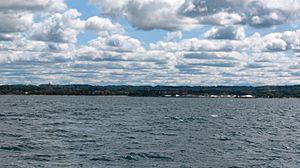
In 1847, Captain Boardman bought land where the Boardman River meets the bay. He and his team built a house and a sawmill there. In 1851, Hannah, Lay & Co. bought the sawmill and made it much bigger. This brought more people to the new community.
By 1853, the only post office in the Grand Traverse Bay area was in Old Mission. Mr. Lay wanted a new post office for his settlement, which was known as "Grand Traverse City." The Post Office Department suggested dropping "Grand" to avoid confusion with the Old Mission post office. So, the name "Traverse City" was chosen for the post office, and the village soon took on that name.
In December 1872, a railroad line reached Traverse City. This helped the area grow and brought in more businesses and people.
Geography and Natural Features
Traverse City is a key part of the Northern Michigan region. It's the main port on Grand Traverse Bay. This bay is a long, natural harbor. It's separated from Lake Michigan by the Leelanau Peninsula. The bay itself is almost evenly divided by a narrow piece of land called Old Mission Peninsula.
The most important waterway in the city is the Boardman River. This river and Boardman Lake are part of the Boardman River Watershed. The river's watershed covers 287 square miles (743 km²). It provides one-third of the water to the bay. It's also one of Michigan's best fishing spots, with over 36 miles (58 km) of its 179 miles (288 km) known for trout fishing. It's even called a "Natural River" by the state.
The city covers about 8.66 square miles (22.43 km²). Most of this is land (8.33 sq mi or 21.57 km²), and a small part is water (0.33 sq mi or 0.85 km²).
Nearby Communities
Here are some communities close to Traverse City:
- East Bay Township, Michigan
- Elmwood Township
- Garfield Township
- Greilickville
- Holiday Hills
- Peninsula Township
- Long Lake Township
Climate and Weather Patterns
Traverse City is located near the 45th parallel. Its weather is greatly affected by Lake Michigan and Grand Traverse Bay. These large bodies of water make the climate milder, especially on the peninsulas north of the city. This is why the area is great for growing grapes for viticulture and Cherry orchards.
Generally, Traverse City has warm, mild summers and cold winters. Lake Michigan and Grand Traverse Bay cause unique coastal weather. This can sometimes lead to sudden and heavy rain or snow. The area gets a lot of "Lake-effect snowfall," which means snow caused by cold air moving over warmer lake water. On average, about 80 inches (203 cm) of snow falls each year. Snow usually falls from November to April, but light snow can sometimes happen as early as late September or as late as May.
The hottest temperature ever recorded in Traverse City was 105°F (41°C) in 1936. The coldest was -33°F (-36°C) on February 17, 1979.
| Climate data for Traverse City Airport, Michigan (1981-2010 normals, extremes 1896) | |||||||||||||
|---|---|---|---|---|---|---|---|---|---|---|---|---|---|
| Month | Jan | Feb | Mar | Apr | May | Jun | Jul | Aug | Sep | Oct | Nov | Dec | Year |
| Record high °F (°C) | 59 (15) |
65 (18) |
87 (31) |
90 (32) |
95 (35) |
104 (40) |
105 (41) |
100 (38) |
96 (36) |
89 (32) |
78 (26) |
64 (18) |
105 (41) |
| Mean daily maximum °F (°C) | 27.8 (−2.3) |
30.4 (−0.9) |
39.9 (4.4) |
53.8 (12.1) |
65.8 (18.8) |
75.6 (24.2) |
80.2 (26.8) |
77.9 (25.5) |
70.0 (21.1) |
57.2 (14.0) |
44.1 (6.7) |
32.3 (0.2) |
54.6 (12.5) |
| Mean daily minimum °F (°C) | 15.2 (−9.3) |
15.0 (−9.4) |
21.6 (−5.8) |
32.1 (0.1) |
41.5 (5.3) |
52.3 (11.3) |
57.8 (14.3) |
56.9 (13.8) |
49.7 (9.8) |
39.2 (4.0) |
30.4 (−0.9) |
21.0 (−6.1) |
36.1 (2.3) |
| Record low °F (°C) | −21 (−29) |
−37 (−38) |
−30 (−34) |
1 (−17) |
17 (−8) |
28 (−2) |
31 (−1) |
32 (0) |
26 (−3) |
15 (−9) |
−5 (−21) |
−26 (−32) |
−37 (−38) |
| Average precipitation inches (mm) | 2.82 (72) |
1.50 (38) |
1.86 (47) |
2.78 (71) |
2.59 (66) |
3.16 (80) |
3.02 (77) |
3.38 (86) |
3.53 (90) |
3.22 (82) |
2.70 (69) |
2.49 (63) |
32.40 (823) |
| Average snowfall inches (cm) | 23.1 (59) |
13.2 (34) |
8.2 (21) |
2.8 (7.1) |
0.1 (0.25) |
0 (0) |
0 (0) |
0 (0) |
0 (0) |
0.2 (0.51) |
7.2 (18) |
19.5 (50) |
74.3 (189) |
| Average precipitation days (≥ 0.01 in) | 17.0 | 12.3 | 11.4 | 10.9 | 10.4 | 9.7 | 8.5 | 9.9 | 12.0 | 13.1 | 14.6 | 16.0 | 145.8 |
| Average snowy days (≥ 0.1 in) | 12.6 | 8.9 | 5.6 | 2.3 | 0.1 | 0 | 0 | 0 | 0 | 0.3 | 4.8 | 11.7 | 46.3 |
| Source 1: NOAA | |||||||||||||
| Source 2: NOAA NOWData | |||||||||||||
People of Traverse City
| Historical population | |||
|---|---|---|---|
| Census | Pop. | %± | |
| 1880 | 1,897 | — | |
| 1890 | 4,353 | 129.5% | |
| 1900 | 9,407 | 116.1% | |
| 1910 | 12,115 | 28.8% | |
| 1920 | 10,925 | −9.8% | |
| 1930 | 12,539 | 14.8% | |
| 1940 | 14,455 | 15.3% | |
| 1950 | 16,974 | 17.4% | |
| 1960 | 18,432 | 8.6% | |
| 1970 | 18,048 | −2.1% | |
| 1980 | 15,516 | −14.0% | |
| 1990 | 15,155 | −2.3% | |
| 2000 | 14,532 | −4.1% | |
| 2010 | 14,674 | 1.0% | |
| 2020 | 15,678 | 6.8% | |
| 2023 (est.) | 15,707 | 7.0% | |
| U.S. Decennial Census | |||
In 2020, Traverse City had 15,678 residents. Most of them (15,341) lived in Grand Traverse County. About 337 people (around 2.1%) lived in Leelanau County.
Religious Communities
Traverse City has different religious groups. It is part of the Roman Catholic Diocese of Gaylord. It is also part of the Episcopal Diocese of Western Michigan and has Grace Episcopal Church.
Economy and Jobs
Many companies have their main offices in Traverse City. These include Hagerty Insurance Agency and Oilgear. There's also 20Fathoms, which helps new technology companies grow.
Fun Things to Do: Arts and Culture
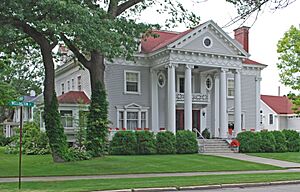
A big part of Traverse City's economy comes from tourism. Many people visit the city for fun!
In November, there's a Beer Week where you can tour breweries, try samples, and learn about making beer.
The National Cherry Festival is held every July. It's a huge event with parades, fireworks, an air show, carnival rides, music, and a cherry pie-eating contest. It's all about cherries!
The Traverse City Film Festival used to happen in July and August from 2005 to 2019.
The Great Lakes Equestrian Festival hosts exciting horse jumping and other riding competitions.
Traverse City State Park is just east of the city. It has about 250 campsites and a beach on the East Bay of Grand Traverse Bay.
The Boardman River Nature Center is a great place to learn about nature. It's the main office for the Grand Traverse Natural Education Reserve, a large 505-acre park and natural area.
Traverse City is very close to two special wine-growing areas: the Leelanau Peninsula AVA and the Old Mission Peninsula AVA. There are over 50 wineries to visit near the city.
You can also see the T/S State of Michigan in the harbor of the Great Lakes Maritime Academy. This 224-foot (68 m) ship used to be a Navy vessel. Now, it's used as a classroom for students at the academy.
A tall ship called the schooner Manitou is also in Traverse City. You can take trips on it!
Performing Arts and Museums
The City Opera House hosts plays, movies, and live shows.
The Traverse Symphony Orchestra has been performing music since 1952.
The Dennos Museum Center is located on the campus of Northwestern Michigan College. It's a great place to see art and exhibits.
Historical Markers Around Town
There are eleven special historical markers in the Traverse City area. These markers tell important stories about the past. They include:
- Bingham District No. 5 Schoolhouse
- City Opera House
- Congregation Beth El
- Grand Traverse Bay
- Grand Traverse County Courthouse
- Great Lakes Sport Fishery
- Ladies Library Association
- Novotny's Saloon
- Park Place Hotel
- Perry Hannah House
- Traverse City State Hospital
Libraries for Learning
Traverse City has the Traverse Area District Library. It has six smaller libraries across Grand Traverse County, so there are many places to find books and learn.
Sports and Recreation
The Huntington Rink is an indoor arena mostly used for ice hockey. It's home to the Traverse City North Stars hockey team.
| Club | Sport | League | Venue | Founded | Reference |
|---|---|---|---|---|---|
| Traverse City Pit Spitters | Baseball | Northwoods League | Turtle Creek Stadium | 2019 | |
| Traverse City Cohos | Hockey | Midwest Junior Hockey League | Centre Ice/Huntington Rink | 2012 | |
| Traverse City Wolves | Football | Great Lakes Football Conference | Thirlby Field | 2007 | |
| Traverse Bay Blues | Rugby | Michigan Rugby Football Union | N/A | 1973 |
The Detroit Red Wings, a famous hockey team, hold their training camp in Traverse City every September. They also host an NHL Prospect Tournament for young players from different teams. Because of this, Traverse City is often called Hockeytown North, like Detroit's nickname, Hockeytown.
Parks and Outdoor Fun
Traverse City has over 30 parks and places for recreation.
The Grand Traverse County Civic Center is a big sports area. It has seven baseball/softball fields, a skatepark, a walking trail, an amphitheater, a sledding hill, a playground, an indoor pool, and an indoor hockey rink. The Grand Traverse Bay YMCA has four centers with swimming, soccer, and tennis.
The TART trail system is a network of trails around Traverse City where you can walk, bike, or run.
Education in Traverse City
Public Schools
Public schools in Traverse City are managed by Traverse City Area Public Schools. The district has 11 elementary schools, two middle schools, and three high schools: Traverse City Central, Traverse City West, and Traverse City High School.
Private Schools
Traverse City also has several private schools.
Interlochen Center for the Arts is a special place for young artists. It includes Interlochen Arts Academy, a private boarding school for fine arts. Founded in 1928, Interlochen is one of the first and best places for young artists to develop their skills. It started with the National Music Camp, now called Interlochen Arts Camp, which brings students and professional artists from all over the world.
For over 45 years, The Pathfinder School has helped children become lifelong learners, global citizens, creative thinkers, and caretakers of the Earth. It was started in 1972 by Arthur and Nancy Baxter, with teachers from Interlochen, The Leelanau School, and Traverse City Public Schools.
The Traverse Children's House is a Montessori school that opened its main campus in 2002. The building was designed to fit the Montessori way of teaching for infants through 6th grade. In 2014, they added 7th and 8th grades. In 2022, this growing program for older students moved to its own campus downtown and is now called Compass Montessori Junior High.
Religious Schools
Grand Traverse Area Catholic Schools manages Catholic schools, including St. Francis High School.
Other religious schools include:
- Traverse City Christian School
- Trinity Lutheran School
- Traverse Bay Mennonite School
- Traverse City Adventist School
Colleges and Universities
Traverse City is home to Northwestern Michigan College. This is a two-year community college with about 5,100 students each year. One of its campuses is at the Cherry Capital Airport, where students can take aviation and auto service classes. Another campus is the Hagerty Center on Grand Traverse Bay. This campus is home to the Great Lakes Maritime Academy, Great Lakes Culinary Institute, Great Lakes Water Studies Institute, and the Hagerty Conference Center.
Media and News
Print Media
The Traverse City Record-Eagle is a daily newspaper that covers 13 counties around the city. It's the official newspaper for Grand Traverse County. You can also find daily copies of the Detroit Free Press, The Detroit News, and The Grand Rapids Press.
Traverse is a monthly magazine about the region.
Village Press and Arbutus Press are also located in Traverse City.
Television Channels
- Channel 7: WPBN-TV (NBC)
- Channel 29: WGTU (ABC)
Radio Stations
There are 16 commercial radio stations in Traverse City with different types of music and shows. Talk radio stations include WTCM, WWMN, WMKT, WSRT, and WLDR. AM 1310 broadcasts sports. WKLT plays rock music, and WNMC is a public radio station for the community. There are also three religious radio stations: W201CM (88.1 FM) and WLJN AM/FM (89.9 FM and 1400 AM). WLDR plays adult contemporary music. Interlochen Center for the Arts broadcasts NPR through Interlochen Public Radio, which serves a large part of Northwest Lower Michigan.
City Infrastructure and Services
Transportation Options
Airports
Cherry Capital Airport in Traverse City is the fourth largest airport in Michigan.
Bus Services
Indian Trails offers bus service to other cities, like St. Ignace to the north and Grand Rapids and Kalamazoo to the south.
Bay Area Transportation Authority provides local bus service within the city.
Main Highways
 US 31 is a major road that goes north and south through the city. In Michigan, it mostly runs along the shore of Lake Michigan.
US 31 is a major road that goes north and south through the city. In Michigan, it mostly runs along the shore of Lake Michigan. M-22 is a beautiful highway that starts in Traverse City. It goes around the Leelanau Peninsula and follows the Lake Michigan shore south to Manistee.
M-22 is a beautiful highway that starts in Traverse City. It goes around the Leelanau Peninsula and follows the Lake Michigan shore south to Manistee. M-37 is another north-south road that passes through the city. Its northern end is at Mission Point Light, north of Traverse City.
M-37 is another north-south road that passes through the city. Its northern end is at Mission Point Light, north of Traverse City. M-72 is an east-west road that crosses the Lower Peninsula of Michigan.
M-72 is an east-west road that crosses the Lower Peninsula of Michigan.
Coast Guard Presence
The Coast Guard Air Station Traverse City is in charge of finding and rescuing people on the water and land in the northern Great Lakes area. Traverse City is one of only two cities in Michigan officially called a Coast Guard City. The other is Grand Haven.
Famous People from Traverse City
Sister Cities
See also
 In Spanish: Traverse City para niños
In Spanish: Traverse City para niños


